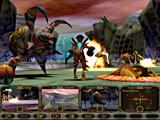 Given that the Human Genome Project is nearing completion and
that we’re already cloning sheep and video games, I suppose it was only a matter of
time until someone created a game about the joys of genetic splicing. Welcome to Evolva, a
graphically superb 3rd person shooter in which you control a squad of four genohunters
whose mission is to scour a planet of the alien parasites that are sucking it dry. As the
game progresses, your genohunters improve their own skills and gain new abilities by
assimilating the DNA of alien and indigenous life forms, and it’s up to you to choose
the mutant path they take. Much like your mutants, the game itself is an intriguing
hybrid; it’s part FPS, part strategy, part puzzle, part RPG—and all these parts
add up to one very good game. Given that the Human Genome Project is nearing completion and
that we’re already cloning sheep and video games, I suppose it was only a matter of
time until someone created a game about the joys of genetic splicing. Welcome to Evolva, a
graphically superb 3rd person shooter in which you control a squad of four genohunters
whose mission is to scour a planet of the alien parasites that are sucking it dry. As the
game progresses, your genohunters improve their own skills and gain new abilities by
assimilating the DNA of alien and indigenous life forms, and it’s up to you to choose
the mutant path they take. Much like your mutants, the game itself is an intriguing
hybrid; it’s part FPS, part strategy, part puzzle, part RPG—and all these parts
add up to one very good game. The first thing you’ll notice about
Evolva is the graphics—they’re astonishing, from the reflective skins on your
genohunters to the atmospheric environments. Of course, you’ll need a hella machine
to revel in all of Evolva’s graphic glory. The game was clearly made with high end
machines in mind—it’s even optimized for the GeForce card, and it’s the
first game I’ve seen that actually recommends a PIII 500 and a TNT II Ultra. And
that’s no fooling. With my PIII 450, 128 MB of RAM, and an TNT II Ultra, I still had
to tone down some of the graphics to get an acceptable frame rate.
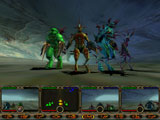 You begin the game with four types of
genohunter, each named according to its most distinctive ability—agile, speed, heavy,
and intel. Though you can control only one of these at a time, you can switch between them
at any time and even give limited attack and movement commands to the other genohunters.
Controls are very simple to use—you can switch back and forth between your characters
and weapons easily, and the game uses the familiar old WASD Quake setup for movement.
It’s a snap to group and ungroup your genohunters, and the game’s camera is
usually excellent--the only time camera angles get a little problematic is when you get
caught in a corner, and switching to first person view can alleviate even that. You begin the game with four types of
genohunter, each named according to its most distinctive ability—agile, speed, heavy,
and intel. Though you can control only one of these at a time, you can switch between them
at any time and even give limited attack and movement commands to the other genohunters.
Controls are very simple to use—you can switch back and forth between your characters
and weapons easily, and the game uses the familiar old WASD Quake setup for movement.
It’s a snap to group and ungroup your genohunters, and the game’s camera is
usually excellent--the only time camera angles get a little problematic is when you get
caught in a corner, and switching to first person view can alleviate even that.
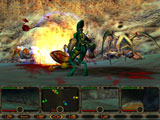 Generally, the game’s twelve
missions are very good; they take a bit of thought to figure out, and are played out in
spacious and colorful environments—this is definitely not a corridor shooter. The
environments can be quite deadly, too—many of the planet’s indigenous plants
either shoot at or blow up on you, and slippery surfaces can cause harsh damage from
falls, so tread lightly. Most missions will tax your brain just enough to be
enjoyable--you’ll have to figure out how to use your weapons and genohunters most
effectively, what skills to build, and when to leave units behind to guard critical areas.
Though some of the missions’ objectives can be vague and confusing, you can generally
figure them out after a while, often with the help of the game’s extremely useful
mini-map with its lifesaver objective pointer. Though
there are only 12 missions, they’re pretty tough, and it’ll take you a while to
play through them. In fact, there’s a lot of save-and-reload involved in Evolva, so
it helps that you can save anywhere. You’ll do that a lot, especially since there’s never enough health around. Generally, the game’s twelve
missions are very good; they take a bit of thought to figure out, and are played out in
spacious and colorful environments—this is definitely not a corridor shooter. The
environments can be quite deadly, too—many of the planet’s indigenous plants
either shoot at or blow up on you, and slippery surfaces can cause harsh damage from
falls, so tread lightly. Most missions will tax your brain just enough to be
enjoyable--you’ll have to figure out how to use your weapons and genohunters most
effectively, what skills to build, and when to leave units behind to guard critical areas.
Though some of the missions’ objectives can be vague and confusing, you can generally
figure them out after a while, often with the help of the game’s extremely useful
mini-map with its lifesaver objective pointer. Though
there are only 12 missions, they’re pretty tough, and it’ll take you a while to
play through them. In fact, there’s a lot of save-and-reload involved in Evolva, so
it helps that you can save anywhere. You’ll do that a lot, especially since there’s never enough health around.
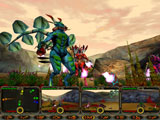 But the most interesting and original
thing about Evolva is the ability to mutate your genohunters. Once you’ve killed and
ingested an alien or indigenous life form, you can incorporate its abilities into your own
gene pool. So if you kill a crablike alien, you will be able give your genohunters claws.
If you kill one that shoots exploding pods, you can give your hunters mortar-like
appendages. Such mutations result in pretty cool changes to your genohunter’s
appearance—arms turn into weapons, spikes sprout from backs, firebreathing organs
grow from necks and mouths. Most of the parasite’s guardians provide weapons, and
most of the indigenous life forms provide less martial abilities—things like jumping,
speed, and armor. The game’s weapons are pretty sharp, from simple-but-deadly close
combat claws to the awesome disrupter gun to sticky, fiery, snot. No kidding, snot. But the most interesting and original
thing about Evolva is the ability to mutate your genohunters. Once you’ve killed and
ingested an alien or indigenous life form, you can incorporate its abilities into your own
gene pool. So if you kill a crablike alien, you will be able give your genohunters claws.
If you kill one that shoots exploding pods, you can give your hunters mortar-like
appendages. Such mutations result in pretty cool changes to your genohunter’s
appearance—arms turn into weapons, spikes sprout from backs, firebreathing organs
grow from necks and mouths. Most of the parasite’s guardians provide weapons, and
most of the indigenous life forms provide less martial abilities—things like jumping,
speed, and armor. The game’s weapons are pretty sharp, from simple-but-deadly close
combat claws to the awesome disrupter gun to sticky, fiery, snot. No kidding, snot.
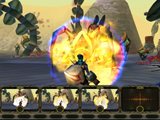 Though you can mutate your genohunters at any time, you’ll
usually want to do so after you absorb a life form with a new ability. At that time you
can switch to the mutator screen, which offers two possible ways to mutate, each of which
usually involves a little bit of trade off. You may, for instance, choose to buff up your
fire-breathing skills—but this may result in a corresponding decrease in your jumping
or claw attack abilities. Generally, though, the choice you’re given is to either
make your genohunter very specialized—you could, for instance make your heavy a close
combat monster by sacrificing its speed and projectile abilities—or you can make your
genohunters well-balanced fighting machines. Both paths have their strengths and
weaknesses, but the freedom to configure your units in various ways really adds to the
game’s replayability. Since you can play with entirely different genohunters each
time, no game is ever quite the same. Though you can mutate your genohunters at any time, you’ll
usually want to do so after you absorb a life form with a new ability. At that time you
can switch to the mutator screen, which offers two possible ways to mutate, each of which
usually involves a little bit of trade off. You may, for instance, choose to buff up your
fire-breathing skills—but this may result in a corresponding decrease in your jumping
or claw attack abilities. Generally, though, the choice you’re given is to either
make your genohunter very specialized—you could, for instance make your heavy a close
combat monster by sacrificing its speed and projectile abilities—or you can make your
genohunters well-balanced fighting machines. Both paths have their strengths and
weaknesses, but the freedom to configure your units in various ways really adds to the
game’s replayability. Since you can play with entirely different genohunters each
time, no game is ever quite the same.
Evolva’s artificial intelligence
really shines. Though you can only control one genohunter at a time, the others embarrass
themselves surprisingly seldom. If you leave one to guard a doorway, it usually will, and
genohunters do a good job of choosing the right weapon for the right threat. You can
usually turn them loose to attack and trust they’ll not kill themselves or you, and
they generally watch their health and the odds. The only chronic AI problem I noticed was
with friendly fire. Your fire will affect your teammates, and sometimes overzealous
genohunters will dart into your line of fire before you have time to react.
For all of the friendly AI’s
virtues, enemy AI is another matter altogether. Parasite guardians are not the most
intelligent of creatures. Though projectile-armed enemies will usually attempt to stand
off, most of them will just run right at you. Thus for all the thought it takes to solve
some of the game’s missions, much of the actual combat comes down to backing up while
firing and using the good old circle strafe.
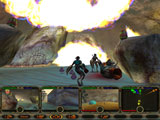 Evolva is mostly excellent, but it does have some problems. The
biggest letdown is that there’s no compelling story here. The genohunters don’t
have much personality, and the missions are challenging but tied together by only the
slightest of narratives. It’s a deadly combination—people you don’t really
care about doing stuff for no particular reason. And there’s a deep irony in the game
as well. Even though you’re supposedly saving a planet from being stripped of life by
alien parasites, that’s actually what you do. The most successful player is
the one who kills all the aliens and indigenous life forms and incorporates their genes
into his or her own gene pool. It’s kind of like being a Borg, and that’s a
little weird. Another weakness is multiplayer. As of this writing, you can only play over
HEAT. That’s just unacceptable. Evolva is mostly excellent, but it does have some problems. The
biggest letdown is that there’s no compelling story here. The genohunters don’t
have much personality, and the missions are challenging but tied together by only the
slightest of narratives. It’s a deadly combination—people you don’t really
care about doing stuff for no particular reason. And there’s a deep irony in the game
as well. Even though you’re supposedly saving a planet from being stripped of life by
alien parasites, that’s actually what you do. The most successful player is
the one who kills all the aliens and indigenous life forms and incorporates their genes
into his or her own gene pool. It’s kind of like being a Borg, and that’s a
little weird. Another weakness is multiplayer. As of this writing, you can only play over
HEAT. That’s just unacceptable.
But overall this is a beautiful,
intelligent, and fun game. Though it may be frustrating at times, and even though the
story is woefully underdeveloped, Evolva’s strengths—an original premise,
excellent AI, thought-provoking missions, and stunning graphics—more than carry the
day. If you’re looking for a different
kind of action game, this one’s for you.
--Rick
Fehrenbacher |
